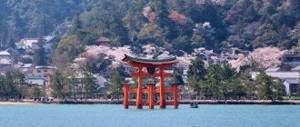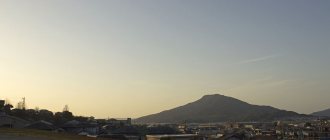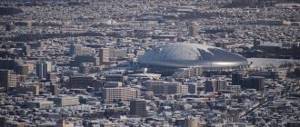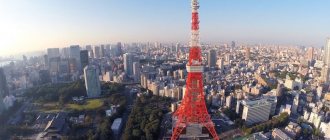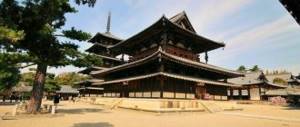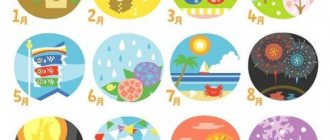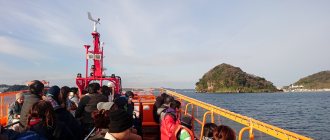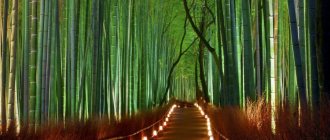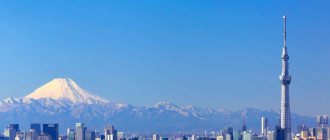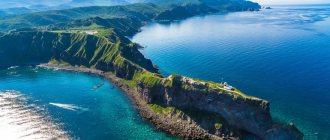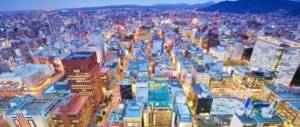Kyushu Island is the third largest island in the Japanese archipelago after Honshu and Hokkaido. Its area is more than forty thousand square kilometers. The island is located in the south and lies in the subtropical climate zone. The mountainous terrain with active volcanoes attracts trekking enthusiasts here. And the hot springs are for those who want to soak themselves and at the same time heal. There is an opinion that the entire Japanese civilization originated in Kyushu. Whether it is true or not is difficult to say, but it was from this island that contacts between the Land of the Rising Sun and the outside world began. On ancient Russian maps, Kyushu was designated as Kiu-Siu or Kiu-Shiu. It is separated from the main Japanese island of Honshu by the Shimonoseki Strait. A bridge and numerous Kammon tunnels (railway, road and pedestrian) are built across this water barrier. In this article we will talk about the nature and attractions of the island of Kyushu. It is rightly considered a famous tourist region.
Where is Kyushu Island
This piece of land is located closer to the coast of South Korea. Therefore, Kyushu became the flagship of contact with Western civilizations after so many years of isolation. Most likely, ancient people from the mainland also arrived here. Therefore, Kyushu is considered the cradle of Japanese culture. From the west, the island is washed by the East China Sea. On the other side, the Pacific Ocean approaches it. And in the northeast the Inland Sea of Japan splashes. Kyushu Island has a mountainous topography. Only in the northwest are there plains and low hills. The highest point - the extinct paleovolcano Kuju (1788 meters above sea level) - is located almost in the center of the island. The western shores of Kyushu are heavily indented and abound in picturesque bays. The island has coal deposits (Hidzen, Miike, Chikugo), although the mountains are composed of volcanic rocks, shales and granites.
Jomon culture (6-5 thousand years BC)
Edo Niland believes that the Ainu appeared on the Japanese islands about 8-7 thousand years ago, which confirms the hypothesis of Japanese ethnogenesis put forward by Oka Masao, since according to Oka the Jomon era began exactly about 8-7 thousand years ago. It is also very possible that the Ainu, at least some of them, arrived on the Japanese Islands not from Asia, but from the Pacific Islands. Niland claims that the Ainu not only made voyages to Alaska for reindeer skins, but also made even longer journeys [!]. [By racial type, the Ainu are light-colored Australoids, with the most significant hairline]
In the area of Oomori, an ancient settlement was discovered, surrounded by heaps of shells, which, according to legend, were left by giant people who once lived here. During the excavations, stone tips for spears and arrows, knives and scrapers, also made of stone, were discovered, as well as magnificent clay vessels decorated with rope prints - “jomon” in Japanese. The most famous monuments of the culture that received this name are clay sculptures - dogu and pottery. Jomon pottery have been found that are more than 12 thousand years old. These are some of the oldest examples of pottery.
Perhaps the Ainu are genetically and linguistically related to the Miao-Yao peoples (several lexical matches). These coincidences can also be explained by ancient Austronesisms. Just 9-8 thousand years ago, the Miao-Austroasiatic branch separated from the Austric language, and from it, 2 millennia later, the Miao-Yao branch, which maintained its unity for many millennia. Perhaps some of the Miao-Yao peoples also took part in the migration of the Austronesians, the founders of the Jomon culture.
Climate of Kyushu
Monsoon plays an important role in shaping weather conditions. Although the island of Kyushu in Japan has a subtropical climate, most rainfall occurs in the summer. The average annual rainfall is three thousand millimeters. The climate of Kyushu is characterized by pronounced altitudinal zones. Thus, in January, on average, the air temperature in the mountains drops to zero, while on the coast the thermometer does not drop below +10 °C. In the hottest month of the year, July, +15 °C is observed at altitude, while at sea it is as much as +26 °C. The winter monsoon often brings typhoons. Warm currents – the Tsushima and Kuroshio currents – play a large role in shaping the climate of Kyushu, especially coastal zones. In the south of the island there are tropical rainforests, dominated by ferns and palm trees. In the rest of the territory of Kyushu, vegetation is subject to altitudinal zonation. Magnolias and camellias grow in the lower tier, pine trees, azaleas, and cryptomerias grow higher, which give way to alpine meadows.
Seismological situation
In addition to the extinct Kuju volcano, the island has no shortage of active ones. The most active is Aso, with a height of 1592 meters. The capricious and unpredictable Sakurajima and Kirishima are not far behind him. The entire island is considered an earthquake zone. Not long ago, Kyushu hit the top news. In mid-April this year, a major earthquake occurred in Japan on the island of Kyushu. Its epicenter, with a magnitude of eight, was located near the city of Kumamoto. A series of aftershocks, which lasted a whole week, claimed forty-four human lives. More than a thousand more people were injured. Due to landslides and destruction, more than one hundred thousand people had to be evacuated. But such a dangerous seismological situation also has another, attractive side. The uncooling depths of the earth give rise to thermal springs. Aso, the most active volcano on the island of Kyushu, provides a stable income for the Beppu spa resort.
Day 5. Beppu
From Yufuin, you can take an hour and a half by train (if you have a JR Pass) or by bus (if you don’t have a pass, then it’s better) to get to Beppu, the onsen capital of Japan. Here, oddly enough, there is no need to stay in a ryokan. There are hot springs in Beppu at every step right in the city, and you should quickly look at them (i.e. you can take a ryokan somewhere on the outskirts, but why, if it was already in Yufuin), and also at them you can cook food.
We stayed near the station at the Beppu Dai-ichi Hotel. Very convenient for unloading in the morning, plus a great breakfast. But if you do everything in Beppu in one day, then it’s probably more fun to live right in the Kannawa area, so that you can return to it in the evening and have dinner there. I googled it - for example, there is a hotel for 11,500 yen for two with a built-in onsen. So look either at the station or in Kannava. There is no need to register at the onsen, it is purely a pleasant bonus.
The main attraction of Beppu is the seven or eight hells (the discrepancy arises due to the fact that one of the hells came out of the association of hells and exists on its own). Hell is a hellishly hot spring, which is not used for bathing, but as a kind of natural installation for tourists.
View this post on Instagram
Mud boiling hell. #hell #jigoku
A post shared by Konstantin Govorun (@litewren) on Oct 20, 2018 at 3:24am PDT
All hells are different. Somewhere through the stones hot steam rises. About once every half hour a geyser shoots ten meters upward. Somewhere white boiling mud comes to the surface, and somewhere red, as if bloody liquid is spilling into a whole lake.
View this post on Instagram
That's about how I boiled my sweet potatoes. #hell #jigoku
A post shared by Konstantin Govorun (@litewren) on Oct 20, 2018 at 3:20am PDT
The accompanying entertainments are arranged around the hells. Somewhere this is a tropical park with palm trees and giant tanuki.
Somewhere, hell is inscribed in a classic Japanese park with ponds and shrines.
It all looks completely alien in places.
View this post on Instagram
Bloody Lake. #beppu #beppu #jigoku
A post shared by Konstantin Govorun (@litewren) on Oct 21, 2018 at 3:25am PDT
The hells are not particularly dangerous because they are fenced off. The main thing is not to stick your head into the mouth of a volcano.
The city of Beppu has only one problem - it is very long and therefore inconvenient, so it is important to explain about the logistics. From the station, you must first take a bus to the Kannawa area, where there are five official hells and one separatist hell (Yama Jigoku). There you need to go to any of the official hells and buy one general ticket (valid everywhere except Yama Jigoku). The easiest way to navigate the buses is with the Official Japan Travel app; maps and signs on site are not very helpful, and walking to Kannawa is boring and long. But the area is very beautiful and very atmospheric. Steam literally comes out from under your feet everywhere.
The best thing to eat in the morning in Kannava is hellish pudding. It is made as if using steam from a geyser, but itself is cold (very tender and tasty).
A little later, in Kannava, you need to start cooking steamed food from hell in such a place (it could be in another, but here everything is clear). The idea is that you buy a set of pre-prepared vegetables and meat and a time slot in a special kitchen hell. Then you personally (under the supervision of local attendants) wearing large protective gloves, lower the pan into hell and after twenty minutes you pull it out and get the finished dish. Everything is explained in English, so you can get through it without difficulty.
View this post on Instagram
I cook food using steam from a volcano, like a real Japanese. #beppu #beppu #jigokumushi
A post shared by Konstantin Govorun (@litewren) on Oct 20, 2018 at 2:45am PDT
It’s generally very cool to walk along Kannava. There are a couple of free foot onsens and a bunch of atmospheric buildings.
View this post on Instagram
Abandoned house in Kannava.
A post shared by Konstantin Govorun (@litewren) on Oct 21, 2018 at 2:45am PDT
But from Kannawa you need to get to two more hells - Lago de sangue Jigoku and Tatsumaki Jigoku.
View this post on Instagram
The geyser moves thirty meters once every thirty minutes.
A post shared by Konstantin Govorun (@litewren) on Oct 21, 2018 at 3:30am PDT
The next destination is a sandy onsen, which can also be reached by bus (or 45 minutes on foot).
Photo by Candace Yu
There is not much space there, so most likely you will be given a number and asked to wait until it is your turn. After this, they will give you a clean yukata and bury it directly in it (on your naked body) in the sand for about fifteen minutes. They will also ask if the ocean is clearly visible. The sand itself is wet and hot from the water from the hot springs, which is supplied through pipes under the sand. The experience is unforgettable, you should definitely do it once in your life. Well, then return to the hotel to rest and have dinner.
The guidebooks, of course, advise visiting the classic onsens in Beppu, but I suddenly have another idea for you - go to a regular bathhouse (sento) for 100 yen. You just need to take shampoo and a towel with you. I recommend this one not far from the station, in an old building. In the evening - that's it. There are a lot of such baths around the city (although it is advisable to know at least a few words of Japanese and understand how the baths work; it’s the same as onsens).
The same bathhouse, photo by AM
If you suddenly want to stay in Beppu for one more day, then half the day can be spent on various onsen delights, and for another half a day go to the cute town of Kitsuki with the smallest castle in Japan and drink green tea with sweets in the cutest tea house (former samurai house ).
View this post on Instagram
We are sitting in a samurai house, drinking tea with sweets - good! #kitsuki #kitsuki
A post shared by Konstantin Govorun (@litewren) on Oct 21, 2018 at 8:52pm PDT
How to get to Kyushu
If you're arriving on the island by air, you'll likely be picked up at Fukuoka International Airport. This hub is connected by many flights to Europe, Asia and the rest of Japan. Airports in other cities in Kyushu offer a smaller range of destinations. Mostly from them you can fly to Shanghai and Seoul. Fukuoka can be reached from South Korea by ferry. The Sanyo Shinkansen high-speed railway starts in Osaka and runs to Kagoshima via Fukuoka. Trains also stop at Kokura and Hakata. A trip on such high-speed trains is equivalent to a tourist attraction: from Tokyo to Fukuoka the entire journey will take only less than six hours. You can arrive to the island through the tunnel by bus. Willer Express sends its cars to Kyushu daily from Tokyo, Osaka and Nagoya.
Day 4. Fukuoka-Yufuin.
Although Fukuoka is the largest city in Kyushu, there is actually very little attention to be paid to it. For example, come in the morning, leave your things at the station (just in case: Fukuoka Station is called Hakata) and go eat tonkotsu ramen. Perhaps it will be the period of flowering of wisteria or cosmos, and you will want to go to the park with flowers, but you can also see cosmos near Yoshinogari Park.
Fatty tonkotsu ramen is a specialty of Fukuoka.
Just in case, a life hack. When I was in Fukuoka, for some reason the price of a regular hotel jumped from the usual 10 thousand yen to 20 thousand. Therefore, I stayed in the neighboring city of Kokura for 6 thousand. Always do this!
But in general, your real destination is the onsen village of Yufuin, which I wrote about here, just scroll down. If you don’t need tonkotsu ramen, then you can completely forget about Fukuoka and go from the city of Saga directly to Yufuin (with a transfer to Tosu).
Typical landscape in Yufuin.
The most beautiful Yufuin no Mori train takes you there. There is also the Yufu train, it is a little simpler and less suitable for viewing the area. Both are included in the JR Pass.
View this post on Instagram
Train to heaven. #japan #kyushu #yufuin
A post shared by Konstantin Govorun (@litewren) on Sep 23, 2015 at 10:27pm PDT
The train deliberately takes you through the most beautiful parts of Kyushu and stops in front of the waterfalls.
The guides even offer help with selfies. Yufuin is a beautiful place, a quiet onsen village where you can see Mount Yufu in the distance, but the area itself is flat. It's a pleasure to walk.
Lake Kinrin. Photo by 오유빈.
That is, souvenirs, food, temples - all this is also there, but I like that this is very traditional Japan. You are walking along a river, next to there are rice fields, and suddenly a heron takes off from the river and flies somewhere about its heron business. Great.
View this post on Instagram
Real Japan. #yufuin #kyushu #japan
A post shared by Konstantin Govorun (@litewren) on Sep 23, 2015 at 5:52am PDT
And, of course, ryokans have complete freedom, because there is a lot of space. There are, for example, private baths with ducks.
And suddenly there is a kotoryokan Waraneko (it’s temporarily not available on Booking, so I’m giving a link to Agoda)! On the outside he is ordinary.
Because you start to notice something.
Even cats for breakfast!
So I sat in the onsen...
And he went to cuddle the cats!
Let me remind you that I lived here, but I found Kotoryokan by accident in 1 minute, so just explore what is in the surrounding area. Surely there will be something cool.
Yufu Dream Museum. Photo by Asikas Chang
So you arrive in the first half of the day, walk around the area a little, then have dinner (you can at a ryokan, you can at restaurants near the station), and enjoy the perfect onsen relaxation. Bliss.
Sights of Nagasaki
This port on the island of Kyushu is also one of the main cities in Japan. It is located in the west, on the shores of Nagasaki Bay. There are so many attractions in this city that we can only list them. A must-see is the Peace Park with the Atomic Bomb Museum and the memorial hall for the victims of the American bombing. Puccini created the opera Madama Butterfly based on the true story of Thomas Glover's love for the daughter of samurai Tsuru Yamamura. There is a garden in Nagasaki where the novel took place. Other attractions in the city include the Suwa and Sanno-jinja temples, the Lessons Cathedral, the monument to the 26 Christian martyrs, Chinatown, the Historical Museum, the ghost island of Hashima, the monastery complexes of Fukusai, Sofuku and Kofuku-ji, and Oura Church.
Honshu
Honshu is the largest island of the Japanese archipelago, its area is about 60% of the area of the entire country. The length of the island is 1300 kilometers, the width ranges from 230 to 50 kilometers. The length of the coastline is 5450 km. The island of Honshu is slightly smaller than the island of Great Britain (British Isles).
More than 100,000,000 people permanently live on Honshu, which is about 80% of the state's residents. It is the most populous of Japan's four main islands. Major Japanese cities such as Tokyo, Osaka, Hiroshima, Kyoto, and Yokohama are located here.
The island of Honshu also has other names - Hondo and Nippon, which are now rarely used.
The island's terrain is mountainous, with many volcanoes among the mountains. The largest of them is Mount Fuji (3.776 m), which is a symbol of Japan. Thanks to her, Honshu ranks 7th among the highest islands in the world. The island experiences frequent earthquakes as it lies at the junction of 3 formation plates.
The climate of Honshu is very diverse - from continental in the north to subtropical in the south. There are very noticeable differences in the climate of the southeastern (Pacific Ocean) and northwestern (Sea of Japan) parts of the island. This is explained by the fact that they are separated from each other by mountains.
Things to do in Kyushu
The mountainous landscape with active volcanoes is one of the attractive attractions of the island. One of the items on the “must do” list is a trip on an ancient train with three carriages, “Hitoyoshi-go,” which runs from the designated point to Kumamoto through the picturesque places of the Kuma River valley. An excursion to the Shimabara Peninsula will be interesting. There was an uprising here in the seventeenth century, as a result of which all of Japan became isolated from the rest of the world for two centuries. Only Dutch and Chinese merchants were allowed to come to Shimabara, and even then under a very limited quota. The Land of the Rising Sun opened its ports to foreigners only in 1854. A trip to Kyushu Island would not be complete without visiting the surrounding area of Aso. This volcano has the world's largest caldera. Several safe walking routes have been developed with observation platforms that offer stunning views of the “lunar landscape” of the Aso lava fields. A more extreme trip would be to Kagoshima. Volcanic ash from Sakurajima falls on the roofs of this city as often as rain.
Day 2 Saga
Having dealt with all the affairs in Kagoshima, we wake up in the morning, activate the JR Pass at Kagoshima-Chuo station and go to the city of Saga, the capital of the prefecture of the same name. There is nothing interesting in the city itself, but it is convenient to travel from it to attractions, and hotels are inexpensive, so we are staying in Saga for two days at once.
If you wake up early and like to move quickly, you can still have time to look at something in Kagoshima before the train, or you can go along the road to Kumamoto and walk there to the castle.
The castle is currently undergoing reconstruction after the earthquake, so the interior is closed. But you can take a walk through the park and look at what is available - for example, at the mansion of the Hosokawa samurai family.
On your first day in Saga Province, leaving your things at the hotel, it is best to go to Yoshinogari Park. The second is to spend it entirely on Nagasaki. If any of these points don't apply, Shimabara and Unzen are worth considering.
Mount Unzen has an excellent onsen resort, but what's more interesting is that you can see plenty of momiji there in late October and early November.
Yoshinogari Park is located on the site of excavations of a large Japanese settlement that existed from the 3rd century BC. to 3rd century AD To make it more fun for tourists, all the main buildings - dwellings, sanctuaries, watchtowers, defensive structures - have been reconstructed. It looks wildly unusual and most closely resembles the dwellings of some barbarians or goblins from fantasy video games.
Photo by Zhenxi Li
The photo above is one of several villages that are built in the park. You can go into almost every house; inside, the life of the ancient Japanese and scenes from their life are reproduced.
The park is so huge that there is even a free bus that runs through it. At the same time, traces of modernity (except for signs with explanations) are almost absent, everywhere you look - colorful ditches and brutal walls made of stakes.
Children in the park are taught to make tools and clothing using the technologies of their ancestors.
Well, or you can endlessly look at the finished artifacts.
There are also excellent rivers and ponds in the park.
View this post on Instagram
Japan without mountains. #saga #japan #saga #japan
Posted by Konstantin Govorun (@litewren) Oct 14, 2021 at 6:50 am PDT
And public events are often held.
View this post on Instagram
Japanese cosplay show at a dog show.
Posted by Konstantin Govorun (@litewren) Oct 14, 2021 at 6:45 am PDT
Children especially have fun.
There are also supplies for outdoor picnics.
For purely logistical reasons, I recommend arriving at Yoshinogari-koen Station, walking around the park, and then exiting on the other side and going to Kanzaki Station. It was from her that we found an excellent field with cosmos (they bloom at the end of October).
View this post on Instagram
Found with @luckydakk a selfie field with cosmos. #cosmos #saga #japan
Posted by Konstantin Govorun (@litewren) Oct 14, 2021 at 12:14 pm PDT
If you have time, you can walk (although it’s an hour one way) north to the Kunen’an Gardens.
It’s not like there’s anything really very important, it’s ordinary quiet rural Japan, with rice fields, small rivers and lazy herons. Well, and temples, of course.
Exploring the park takes about two-thirds of the day, which is why before arriving in Saga I recommend stopping somewhere and looking at something else.
The easiest way to live in Saga is in an APA hotel right next to the station. There are even two of them, and they cost 8,000 yen per night for two. Fine. There are also plenty of alternative hotels.
Kyushu Island attractions
Fukuoka is an eternally young and vibrant city. Nightclubs, high-tech museums and traditional Japanese culture live side by side here. Here you can go to a performance at the Kabuki and Noh theaters, as well as interact with the latest robot designs in Robosquare. It's also good to get a bird's eye view of Fukuoka by climbing the 234-meter tower. Fujisaki Shrine, Suizenji Castle and Garden are must-sees in Kumamotu. Kyushu is famous throughout Japan for its thermal springs. To soak in them, you should go to the Beppu resort. The most famous is the complex of hot springs under the ominous name “Nine Hells”. If mountain trekking is your thing, head to the Kirishima Southern Volcanic Range. Well, if you are a surfing fan, go to the beaches of Miyazaki.
Day 6. Takachiho
This is the last day of validity of the local JR Pass (because it was activated on the second day of the trip). You need to take the train early in the morning to Nobeoka Station, and then take a bus to Takachiho. If the ticket office at the station is open at this time, you can show your passport and buy a special cheaper ticket for foreigners; if not, just pay the driver about 1,700 yen.
Takachiho is a small town in the mountains, and it immediately welcomes visitors with themed statues.
There are two must-see spots in Takachiho, and the best place to start is from the gorge. First, you will walk along the path from above and watch how people below, in the rays of sunlight, ride between steep rocks, swim under a waterfall and enjoy the beauty of naked mountain flesh (sorry for the pathos, but this is really something amazing).
Then you reach the tourist center with food and souvenir shops, where you must enjoy the flying noodles.
The idea is that you sit on a bench, and the thinnest somen noodles fly past you along a bamboo chute, and you need to catch them with chopsticks, dip them in the sauce and eat them. If you don’t catch it, your friend on the bench next to you catches it. If you screw up, there is a consolation basket at the end, which the waiter brings at the end of the attraction (so you end up eating all the noodles you paid for). This is a unique serving method that was invented (sort of) specifically in Takachiho.
You can take a ride on the boats yourself, or you can go further along the gorge. Points of interest are labeled, and this is important because Takachiho is inextricably linked with the myths of the creation of Japan and the first emperor.
But from this island, according to legend, the creation of all the Japanese islands began.
The road goes up.
And then all the way up.
There is a large and important Shinto shrine near the gorge, but it will be needed late in the evening, so the next point on the route is Amanoivato-jinja, near the place where the beautiful goddess Amaterasu sat in a cave, and the gods tried to lure her out of there. You can read more about this story, for example, on Wiki. You can’t reach the sanctuary on foot; you have to take a local bus (from the same station where the bus from Nobeoka brought you). It is not far.
Tourists are not allowed into the cave itself, but in the temple you can look at the mirror (a replica of the mirror from the myth).
View this post on Instagram
The mirror with which Amaterasu was lured out of the cave. #takachiho #takachiho #amanoiwatoshrine
A post shared by Konstantin Govorun (@litewren) on Oct 19, 2018 at 5:43pm PDT
And also take a walk along the pilgrims' road to another cave - where the gods sat and thought about what to do with Amaterasu. Pilgrims bring pebbles to this cave and build characteristic pyramids from them.
In the cave itself everything is lined with pyramids.
I've never seen anything like this anywhere else. But the road to the cave also offers incredibly beautiful views.
The water is especially pleasing, that same Japanese blue-green color and pure.
In the evening, you can have dinner at the restaurants near the bus station, and then go to Takachiho Shrine (the same one on the road to the gorge) for an evening kagura dance. This dance consists of 33 episodes and retells the very legend of the Amaterasu Cave in every detail, but it is fully performed only on festival days (every Saturday from mid-November to mid-February). On all other days, a shortened version of only four episodes is danced in the temple. They run for about an hour (from 8 to 9 pm), all this time you have to sit on the floor, and this pleasure costs 700 yen (you can buy it directly at the box office before the performance).
After this, all that remains is to return to the hotel, spend the night, and take a bus to Kumamoto in the morning. By the way, you should buy tickets for it a day earlier to be sure of getting there (the bus runs twice, in the morning and in the evening).
If you still have time, you can pick up a map of the area at the visitor center and walk to the place where the first Japanese Emperor Jimmu was born. But this is optional.
View this post on Instagram
On February 13, 711 BC, Emperor Jimmu was born on this site. His descendants still rule Japan today. #takachiho
A post shared by Konstantin Govorun (@litewren) on Oct 18, 2018 at 11:56pm PDT
In Takachiho we lived in such a guest house. Nothing fancy, just traditional tatami rooms with mountain views for 7,600 yen for two.
True, the amenities were on the floor. If this bothers you, you can rent a ryokan for 14,000 without kaiseki and 24,000 with kaiseki.
What to try and buy as a souvenir
The island of Kyushu is famous for its cuisine. In Kumamoto, you need to try the signature dish, karashirenkon. It is a lotus stem stuffed with mustard seeds and fried in a wheat and soy coating. On the island of Kyushu, as in Catalonia, black pigs are raised. Therefore, the local specialty is the Japanese equivalent of jamon - tonkotsu ramen. Basashi is raw horse meat in soy sauce, eaten with ginger. A variety of tropical fruits and sugar cane are grown on the southern island of Kyushu. For drinks, you should try shochu. This region is famous for its pottery making. Cookware should be purchased from Arita and Karatsu.
Train JR Ibusuki no Tamatebako
A curious panoramic train runs between the regional capital Kagoshima and Ibusuki: one side is painted black, symbolizing the side of the mountains, the other is white, symbolizing the sea. The name Ibusuki no Tamatebako means “Ibusuki Treasure Box” in honor of the Japanese legend of Urashima Taro: an earthly youth, a princess from the underwater kingdom and a magic box. As you drive, you can see ancient train stations, Kinko Bay and Sakurajima. Inside, the train is decorated with retro wood, there are drawings on the walls illustrating the fairy tale about the Tarot, and the driver wears a blue uniform and white gloves. You ride and feel like Jiro in “The Wind Rises” during his train journeys.
Amami No Sato Garden
